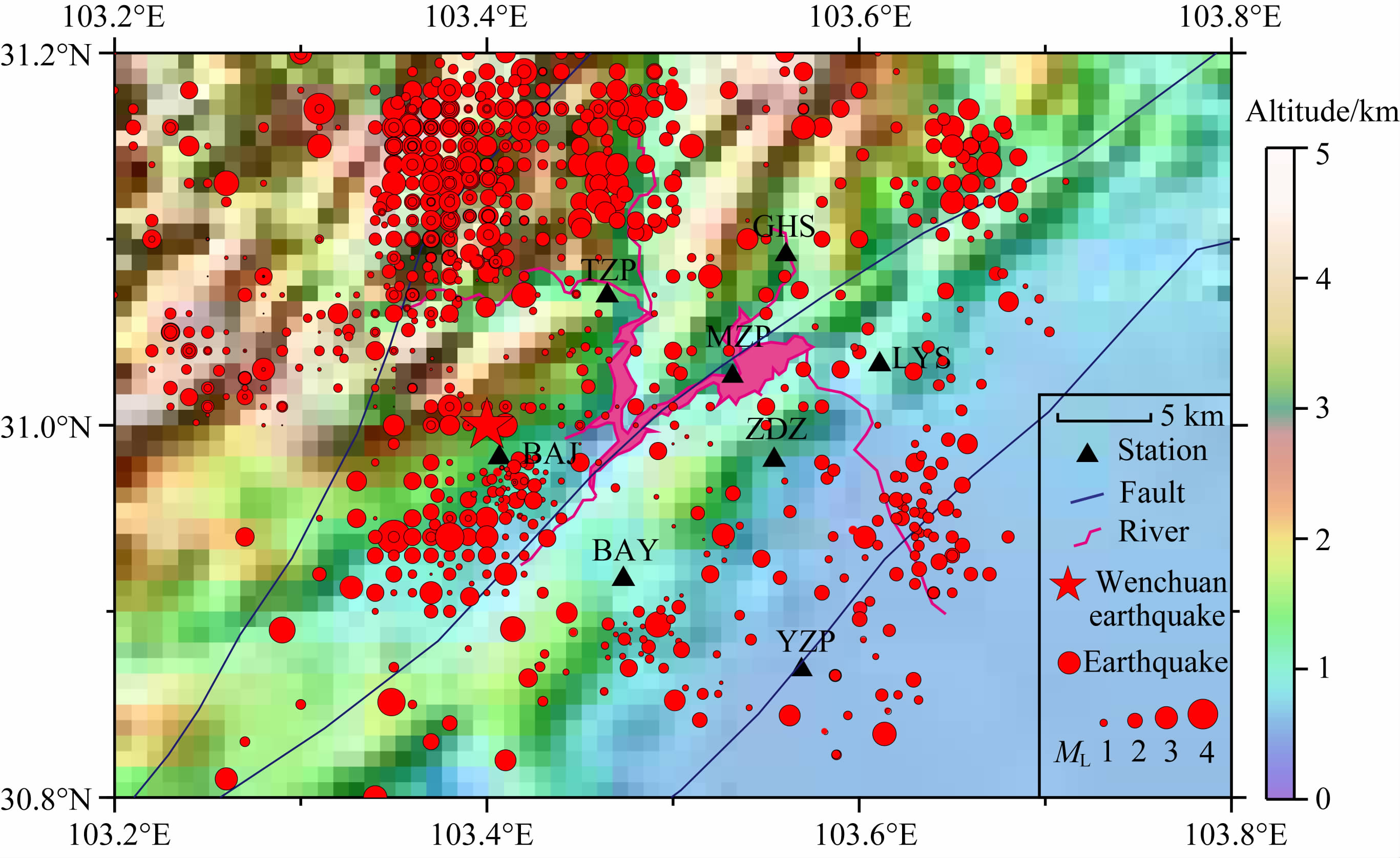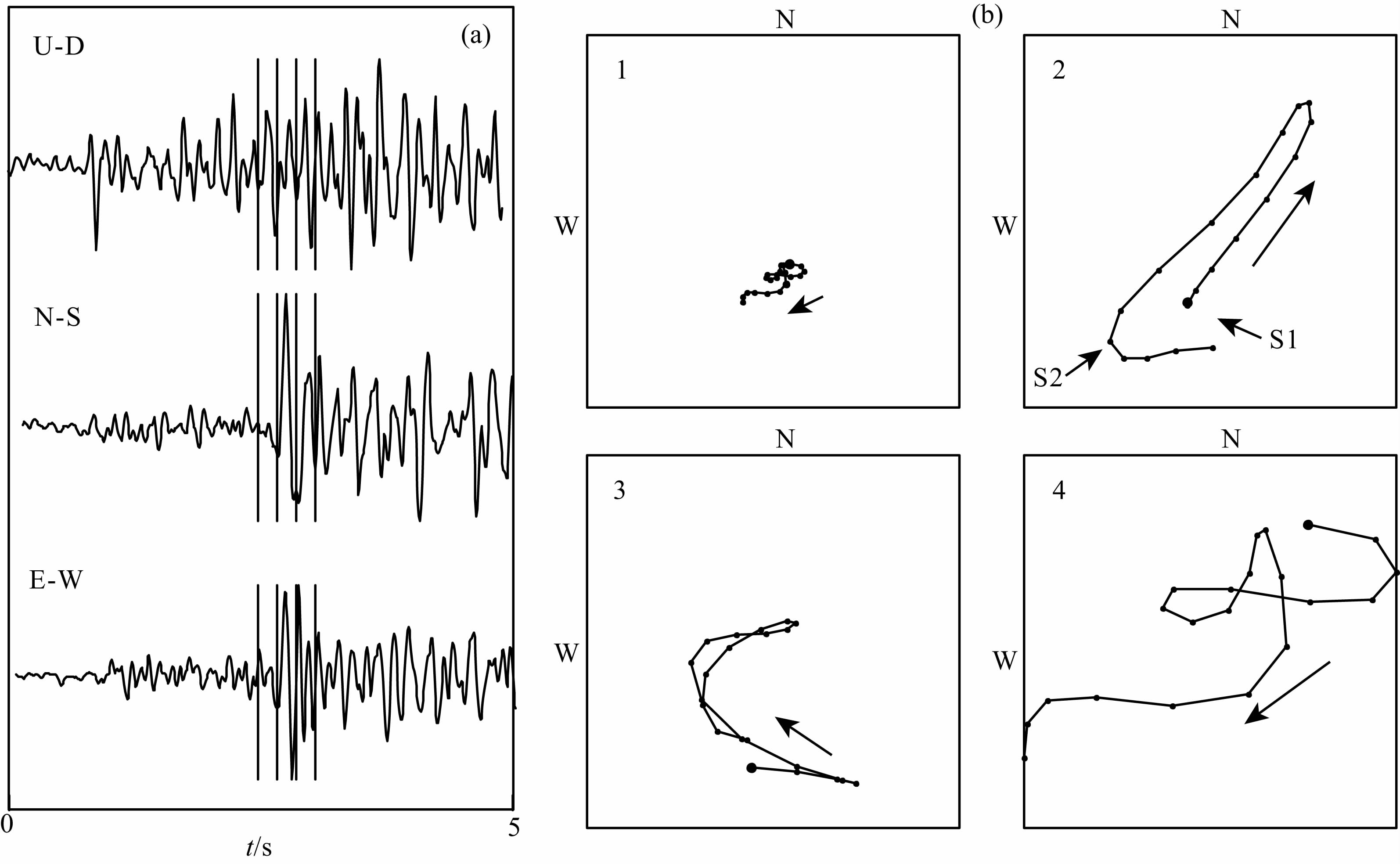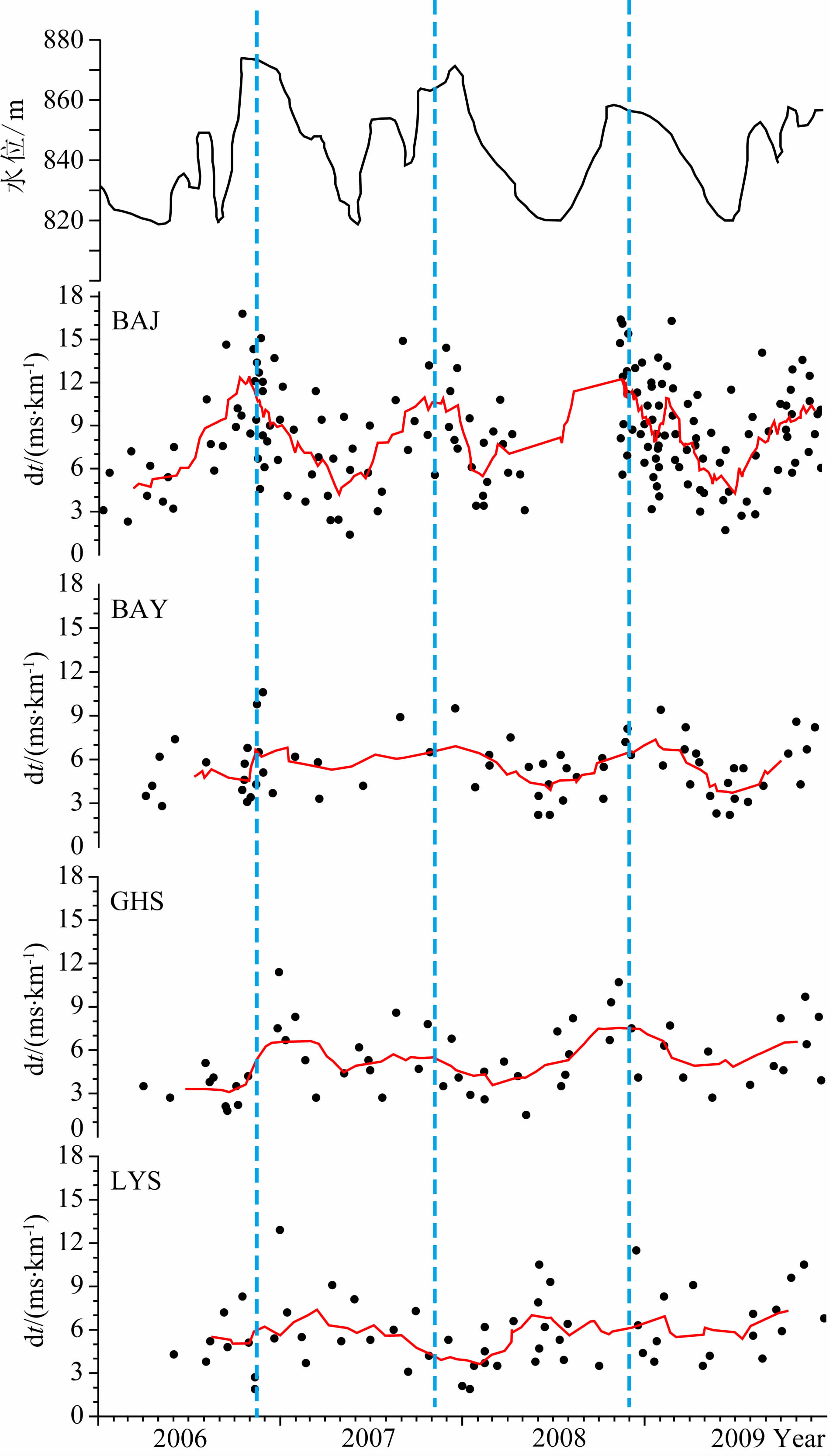2. 四川省地震局, 成都 610041
2. Earthquake Administration of Sichuan Province, Chengdu 610041, China
Shear wave splitting can be used to detect the stress change in the crust, and obtain the anisotropic static and dynamic gauge. The polarization direction of fast shear waves is consistent with the direction of cracks in the crust, indicating the regional stress direction in the crust. The time delay of the slow shear waves is related to the distribution of the micro-cracks in the crust which implies the change of water pressure in the crust. And the delay time can be used to study the effect of reservoir water level on the crustal anisotropy. This paper obtained the shear wave splitting parameters by the polarization analysis with high accuracy and strong visuality, using seismic data recorded by 8 seismic stations in the Zipingpu reservoir area from 2006 to 2009. According to the velocity model of the shallow exploration, the shear wave window chosen in this paper is 58 degree. The focal depths of the earthquakes are in the range of 5~12 km, and the signal to noise ratio of shear waves is greater than 6.0. 512 seismic events are justified by the data selection criteria. On the basis of the particle moving figures, we choose the position where the particle trajectory deflects vertically to ascertain the arrival time of fast and slow shear waves.
Every seismic station recorded more than 30 events in the study area, and the polarization direction at each station is obvious. Combining with the relationship between the seismic activity and water level of the Zipingpu reservoir, this paper obtains the variation characteristics of the stress in the crust. The results of shear wave splitting show two polarization directions of fast shear waves, which are northeast and northwest. The northeast polarization direction of fast shear waves is consistent with the strike of the Longmenshan fault. And the northwest direction agrees with the direction of the regional principal compressive stress. The average delay time of the slow shear waves in the reservoir is 5.8 ms·km-1. The large delay time of the slow shear waves is from the station BAJ and LYS at the dam and reservoir tail, respectively, where the stress change is large because of the water storage and drainage in the reservoir. The small delay time is from the station YZP far from the reservoir, where the stress in the crust is affected least by the water level of the reservoir.
Comparison with the previous results of shear wave splitting in the Zipingpu reservoir shows agreement with our results. The polarization direction of fast shear waves is consistent with the direction of the regional principal compressive stress and the strike of active faults. The relationship between the delay time of the slow shear waves and the water level of the reservoir suggests the increase of water level in the reservoir is often accompanied with the increase of the delay time. The reservoir storage causes the diffusion of the pore pressure in the crust, which makes the aspect ratio of the microcracks in the crust increase.
近些年来,随着国内外大型高坝水库的不断兴建,水库诱发地震事件也随之增多.水库蓄水或排水通常会引起地壳岩体中应力集中和能量释放而产生地震(秦嘉政等,2009).这些地震位置一般邻近重要的水库工程设施,而且震源较浅,震中烈度相对较高,往往具有很大的破坏性,造成大坝及附近建筑物的破坏和人员伤亡,甚至引起滑坡、坍塌等严重的次生灾害.因此,水库地区地震的研究不仅是水利水电工程研究的内容,也是地震学研究的重要内容之一.
剪切波分裂作为一个有效的观测手段,可用于对地壳应力、流体压力等方面的探索(张永久等,2010; Gao et al.,2011; Tang et al.,2005).剪切波分裂参数快波偏振方向和慢波延迟时间是用于分析地壳应力场的状态和各向异性参数的静态和动态探讨的重要依据(Crampin,1984; 高原等,1999).剪切波分裂对地壳中各向异性介质较为敏感,与地壳应力场和断裂线的分布密切相关.快波偏振方向与地壳微裂隙排列方向一致,与原地主压应力的方向一致(Crampin,1978; Zhang et al.,2000; Musumeci et al.,2005).慢波延迟时间通常是评价各向异性程度的物理量,对地壳中微裂隙的几何形态和密度分布非常敏感,可以反映地震发生前后应力的积累与释放过程,而且也可以很好地反映地壳中水压变化所引起的微裂隙变化.
紫坪铺水库位于四川省都江堰市北西9 km处的岷江上游,是一座坝高156 m库容11.12亿立方米的大型水利工程.紫坪铺水库已经建立了专门用来监测水库地区中小地震的数字遥测地震台网,该地震台网由7个台站组成.在紫坪铺水库库区还有油榨坪台站,属于四川地震台网.自2005年9月紫坪铺水库下闸蓄水之后,库区弱震活动频繁,为紫坪铺水库库区地震相关研究提供了丰富的数据资料(胡先明,2007;雷兴林等,2008).
之前有学者(张永久等,2010)已经对紫坪铺水库库区剪切波分裂进行探讨,获得了水库库区各向异性特征.该结果采用的是紫坪铺水库库区2004年8月—2008年5月汶川地震之前的地震数据,本文选择2006—2009年紫坪铺水库库区的地震波形资料,获得水库库区的各向异性特征,进而分析水库水位的变化与地壳应力的变化关系,并对比张永久等(2010)的结果,探讨两次剪切波分裂获得的地震各向异性特征有何异同.
2 地震和水位数据紫坪铺水库位于龙门山断裂带中段,龙门山断裂带处于中国大陆南北地震带的中部,东南侧为扬子准地台,西侧为松潘—甘孜地块.地震震源机制解结果表明龙门山断裂带所处地区的现代应力场主压应力轴方位为北西西向(邓起东等,1994).紫坪铺水库自2005年9月下闸蓄水之后弱震活动较为活跃,为剪切波分裂研究提供了丰富的数据资料.本文选取了2006—2009年紫坪铺水库库区8个地震台站记录的地震数据,包括紫坪铺水库数字地震台网的7个台站(八角BAJ,白岩BAY,桂花树GHS,灵岩寺LYS,庙子坪MZP,桃子坪TZP,钻洞子ZDZ)和四川数字地震台网的油榨坪YZP台站,8个台站平均台间距10 km左右,采样率为100 sps(samples per second)(图 1).
 | 图 1 紫坪铺水库库区地震(2006—2009年)和台站分布Fig. 1 Distribution of earthquakes (2006—2009) and stations in Zipingpu reservoir |
在2006—2009年整个观测时间段内,紫坪铺水库水位起伏较大,水库库区弱震活动较强(图 2).M-T图显示水库库区没有大于4.0级的地震,地震震级主要集中在3.0级以下.而且水库库区地震活动与水库水位的升降变化有一定的相关性.2006年上半年水库水位处于830 m左右,8月13日开始,水库水位开始出现大幅度上升,到10月7日累计上升54 m,此后水位开始下降,地震活动从2006年8月开始逐渐增强.2007年5月20日水库水位再次上升,12月14日水位达到高值后开始下降,直到2008年6月降至820 m.2008年2月库区地震活动性较强.2008年11月,水库水位再次达到峰值随后下降.2009年6月水库水位重新开始上升,地震活动性在2009年下半年也表现出逐渐增强的趋势.
 | 图 2 紫坪铺水库库区水库水位变化(a),地震M-T(b)及N-T(c)图Fig. 2 The water level (a), M-T (b) and N-T (c) of Zipingpu reservoir |
本文采用偏振分析法获得剪切波分裂参数,偏振分析法虽然计算速度较慢,但是准确率较高,直观性强(Crampin et al.,2006).
剪切波分裂方法研究地壳各向异性要求选取的地震波记录必须在剪切波窗口内.利用剪切波分裂探讨地壳介质的各向异性,还要求地震数据有较高的信噪比.根据浅层勘探给出的速度模型(表 1)(赵珠等,1997),该地区深度12 km,震中距20 km的地震入射角大约58°时,实际地震射线的入射角仅35°.因此本文选取58°的入射角作为剪切波窗口.对数据进行进一步的筛选,选取地震事件震源深度在5~12 km范围内,而且剪切波信噪比大于6.0.最后符合剪切波分裂计算条件的地震数据共512条(表 2).
| | 表 1 剪切波速度模型 Table 1 The velocity model of shear wave |
| | 表 2 四川紫坪铺水库库区地震台站剪切波分裂参数 Table 2 The parameters of shear wave splitting in Zipingpu reservoir |
在确定剪切波分裂参数时,文中选取剪切波到时前20个采样点和到时后40个采样点的波形数据窗口(时长0.6 s),将这60个采样点数据分为三段分别绘制质点偏振图进行分析(图 3).画出所有满足数据要求的质点偏振图,然后从这些图中挑选出快剪切波质点振动为线性或近于线性的质点偏振图.由于各向异性介质的存在,剪切波偏振方向第一个突然转变的位置被认为是快剪切波的到达,慢剪切波的到达同样也是极化偏振方向的突然转变,快、慢剪切波到时差即为慢波延迟时间(图 3).
 | 图 3 BAJ(八角台)剪切波分裂分析示意图 (a) 为三分量波形图;(b) 为质点偏振图;(a)图4条竖线表示用于质点偏振分析的三段波形;1)(a)图第一段地震波质点偏振图;2)(a)图第 二段地震波质点偏振图;3)(a)图第三段地震波质点偏振图;4)图1的放大图;箭头表示质点运动方向;S1,S2分别为快波和慢波到时.Fig. 3 The results of shear wave splitting analysis at BAJ station (a) is the waveform; (b) is the trail of particle;The four vertical lines in (a) are the three section waveforms for polarization analysis; 1) The trail of particle of the first section waveform in (a); 2) The trail of particle of the second section waveform in (a); 3) The trail of particle of the third section waveform in (a); 4) The enlargement of the figure 1; Arrows are the direction of particle moving; S1,S2 is the arrival of fast wave and slow wave, respectively. |
快波偏振方向通常反映了原地主压应力的方向,与地壳中应力诱发的定向排列的微裂隙面的走向一致(赖院根等,2006;高原等,1995;石玉涛等,2009).从表 2可以看出,8个台站均得到了30条以上的可靠结果,特别是BAJ台有172个结果.剪切波分裂结果统计8个台站的快波偏振方向均有两个,本文分别计算剪切波分裂参数平均值以及对应的均方根误差.快波偏振方向的误差结果都小于30°,表明各个台站的快波偏振方向优势取向都较为明显.结果显示研究区域内快波偏振方向主要有两个,分别为北西向和北东向.
快波偏振方向等面积投影图(图 4)显示,研究区域内8个台站快波偏振方向有两个,但是其优势取向都较为明显.BAJ台,BAY台,GHS台,LYS台,MZP台,TZP台和ZDZ台7个台站快波偏振方向显示为北西向和北东向,而YZP台的结果为北东向和近似的南北向.北东向的快波偏振方向与龙门山断裂带的走向一致,北西向的快波偏振方向与研究区域主压应力的方向一致.
 | 图 4 剪切波偏振方向等面积极射投影与等面积玫瑰图 短线的方向是台站记录的每个地震事件的快剪切波偏振方向.Fig. 4 Lower hemispherical project and equal-area rose diagram of fast shear wave polarization directions The directions of the short lines is each polarization of the fast shear wave recorded by stations. |
慢波延迟时间对地壳中微裂隙的几何形态较为敏感,因此它在一定程度上反映了地壳中应力的分布特点(Gao and Crampin,2008; Liu et al.,2014).研究区域内512条地震事件的慢波延迟时间平均值为5.8 ms·km-1.慢波延迟时间的最大值位于八角台(BAJ),两个方向上的慢波延迟时间分别是(7.7±3.8)ms·km-1,(8.1±3.1)ms·km-1.其次是灵岩寺台(LYS),两个方向上的慢波延迟时间分别是(6.5±2.9)ms·km-1,(5.4±2.0)ms·km-1.最小值位于油榨坪台(YZP),两个方向上的慢波延迟时间分别是(3.8±1.6)ms·km-1,(4.2±1.7)ms·km-1.其余5个台站慢波延迟时间多集中在5 ms·km-1左右(表 2).慢波延迟时间较大的灵岩寺台和八角台分别位于紫坪铺水库的库坝区和库尾区(图 1),正好是处于水库蓄水引起地壳应力变化较大的两个区域.慢波延迟时间最小的油榨坪台距离水库最远,地壳应力受水库水位变化影响最小.可见,水库的库坝和库尾地区地壳应力受水库水位的影响较大.
由于慢波延迟时间的离散性,本文采用 7点滑动平均来表示慢波延迟时间在时间上的变化.慢波延迟时间的7点滑动平均曲线显示慢波延迟时间变化较为明显,特别是BAJ,BAY,GHS和LYS台站(图 5).BAJ台站慢波延迟时间从2006年初开始升高直到10月底升至12 ms·km-1,随后慢波延迟时间开始下降直到2007年4月.之后,慢波延迟时间再次升高直到2007年10月.2007年年底,慢波延迟时间一直维持在11 ms·km-1,随后降低至7 ms·km-1.2008年2月,慢波延迟时间再次升高直到2008年10月,12月慢波延迟时间又一次降低,2009年7月降至4 ms·km-1,随后开始持续升高.BAY台站在2006年和2007年,慢波延迟时间变化不明显,2008年年初开始稍有降低.2008年7月慢波延迟时间上升直到2009年初,随后开始降低,7月降至最低3.5 ms·km-1.GHS台站慢波延迟时间也可以观测到变化的趋势,在2006年底和2008年11月分别可以观测到慢波延迟时间的两个峰值,达到7 ms·km-1.在LYS台站,慢波延迟时间的变化较小,在2007年底慢波延迟时间出现低谷,低至4 ms·km-1.
 | 图 5 慢波延迟时间与水库水位对比图 黑点为慢波延迟时间计算值;红色曲线为7点滑动平均值;蓝色虚线为水库水位与慢波延迟时间对比线.Fig. 5 The comparison between the delay time of slow wave and water level in reservoir The black dots are values of delay time, and red line is the result of 7 point moving average. The blue dashed lines are comparison between the water level and delay time of slow shear waves. |
慢波延迟时间对地壳应力场所引起的微裂隙变化非常敏感.紫坪铺水库库区慢波延迟时间在观测时间段内表现出了很好的一致性变化.为了分析水库水位对地壳应力变化的影响,文中将慢波延迟时间变化与水库水位变化进行对比分析(图 5).结果显示慢波延迟时间的变化和水库水位之间存在很好的一致性.每当水库水位出现大幅度上升,慢波延迟时间也同步出现相应的增大;水位下降之后,慢波延迟时间随之减小.这一结果与之前的结果(张永久等,2010)较为吻合.水库水位与慢波延迟时间的一致变化关系在Gao和Crampin(2003)关于慢剪切波时间延迟变化与压力变化的试验中也得到了证实.水库的蓄水与排水通常会引起地壳流体压力的变化,剪切波分裂慢波延迟时间可能会由于地壳应力的微小变化而产生显著的变化,该结论也与Crampin和Zatsepin(1997)所提出的APE(Anisotropic Poro-elasticity,各向异性孔隙弹性)理论相吻合.
6 地震各向异性的讨论紫坪铺水库位于龙门山断裂带上,龙门山断裂带作为2008年汶川地震的发震断裂,在构造上极其复杂.快波偏振方向通常与区域主压应力方向或者活动断裂的走向表现一致.研究区域中,8个台站均显示有两个快波偏振方向,BAJ台,BAY台,GHS台,LYS台,MZP台,TZP台和ZDZ台7个台站剪切波分裂快波偏振方向显示北东和北西两个方向,而YZP台快波偏振方向为北东向和近似南北向.YZP台站北东向的快波偏振方向与断裂带的走向一致,南北向的快波偏振方向与其他台站结果存在较大差异,与断裂带走向和最大主压应力方向也不一致.南北向的快波偏振方向结果与张永久等(2010)的结果相一致,证实了本文结果的可靠性.YZP台站位于紫坪铺水库东南方向,慢波延迟时间的结果显示该台站受到水库影响较小,该台站南北向快波偏振方向反映了YZP台站附近复杂的应力场,该区域应力方向并不仅仅是受到龙门山活动断裂带单一的影响,也暗示了附近隐伏断层的情况.以往的研究结果(高原等,1995;赖院根等,2006;石玉涛等2009)也表明快波偏振方向也揭示了新的构造.
对比张永久等(2010)的结果(图 6),BAJ台,LYS台,ZDZ台,YZP台和BAY台快波偏振方向均有两个方向.本文的结果中MZP台,TZP台和GHS台仍然有两个快波偏振方向,而之前的结果(张永久等,2010)显示只有一个快波偏振方向.本文的地震数据采用的是2006—2009年,跨越汶川地震.通常大地震的发生会使得震区地壳应力进行调整,进而快波偏振方向表现的较为零散,所以本文观测到这三个台站快波偏振方向有两个.较之前的结果,MZP台和TZP台快波偏振方向多了北东向,与龙门山活动断裂的走向一致.而GHS台多了北西向的快波偏振方向.
 | 图 6 紫坪铺水库库区快剪切波偏振方向
黑色短线为本文结果;蓝色为张永久等(2010)结果.Fig. 6 The polarization directions of fast shear wave in Zipingpu reservoir Black lines are the results in this paper; Blue ones are from Zhang et al.(2010). |
紫坪铺水库8个地震台站慢波延迟时间平均值为5.8 ms·km-1,与张永久等(2010)的结果5.38 ms·km-1近似.位于库尾的白岩台(BAY)和库坝的灵岩寺台(LYS)慢波延迟时间明显大于其他几个台站.水库的库坝和库尾相比于水库其他地区地壳水压较大,使得微裂隙孔隙流体压力增强,慢波延迟时间将表现出较大的值,这一结果表明紫坪铺水库库坝和库尾附近是地壳应力相对较大的区域.对比慢波延迟时间与水库水位之间的关系表明两者之间的变化有一定的相关性,水库水位的增加往往伴随着慢波延迟时间的增大,这是由于水库蓄水导致了地壳中孔隙压力的扩散(Talwani,1997;陶玮等,2014),使得地壳裂隙孔隙压强增大,进而观测到慢波延迟时间的增大.
本文使用的地震数据资料跨越汶川地震,对比汶川地震之前的剪切波分裂结果(张永久等,2010)发现,紫坪铺库区8个地震台站快波偏振方向结果基本一致,慢波延迟时间反映的各向异性程度也相当.水库周围的慢波延迟时间主要受到水库水位的影响,与地壳水压的变化相关.本文得到的剪切波分裂结果初步反映了水库库区的区域应力情况以及水库的蓄水排水对地壳应力的影响.
7 结论紫坪铺水库自2005年9月下闸蓄水之后,水库库区弱震活动频繁. 而且紫坪铺水库已经建立了专门用于监测水库地区中小地震的数字遥测地震台网,积累了大量的地震数据资料. 本文利用2006—2009年紫坪铺水库库区8个地震台站记录的地震事件,采用剪切波分裂方法分析了水库库区地壳应力的分布特征,同时也探讨了水库水位的变化对剪切波分裂参数的影响.
紫坪铺水库库区剪切波分裂快波偏振方向主要有两个,北东向和北西向,反映了研究区域内地壳各向异性的分布特征. 本文的结果与之前的剪切波分裂结果表现一致,紫坪铺水库地区快波偏振方向和区域主压应力的方向、龙门山断裂的走向一致. 紫坪铺水库8个台站慢波延迟时间平均值为5.8 ms·km-1. 水库的库坝和库尾相比于水库其他地区慢波延迟时间要大,表明库坝和库尾是地壳应力相对较大的地区.水库库区慢波延迟时间与水库水位之间表现出了很好的一致性变化. 水库的蓄水和排水通常会引起地壳水压的变化,进而使得地壳裂隙孔隙压强发生相应的变化.
致谢 感谢四川省地震局为本文的研究提供数据的支持和帮助;感谢两位匿名评审专家提出的宝贵意见.| [1] | Crampin S. 1978. Seismic-wave propagation through a cracked solid: polarization as a possible dilatancy diagnostic. Geophys. J. Int., 53(3): 467-496. |
| [2] | Crampin S. 1984. An introduction to wave propagation in anisotropic media. Geophys. J. Int., 76(1): 17-28. |
| [3] | Crampin S, Gao Y. 2006. A review of techniques for measuring shear-wave splitting above small earthquakes. Phys. Earth. Planet. Inter., 159: 1-14. |
| [4] | Crampin S, Zatsepin S V. 1997. Modelling the compliance of crustal rock—II. Response to temporal changes before earthquakes. Geophys. J. Int., 129(3): 495-506. |
| [5] | Deng Q D, Chen S F, Zhao X L. 1994. Tectonics, seismicity and dynamics of Longmenshan Mountains and its adjacent regions. Seismological and Geology (in Chinese), 16(4): 389-403. |
| [6] | Gao Y, Zheng S H, Sun Y. 1995. Crustal crack anisotropy in Tangshan. Acta Seismologica Sinica (in Chinese), 17(3): 283-293. |
| [7] | Gao Y, Zheng S H, Zhou H L. 1999. Polarization patterns of fast shear wave in Tangshan region and their variations. Chinese J. Geophys. (in Chinese), 42(2): 228-232. |
| [8] | Gao Y, Crampin S. 2003. Temporal variations of shear-wave splitting in field and laboratory studies in China. J. Appl. Geophys., 54(3-4): 279-287. |
| [9] | Gao Y, Crampin S. 2008. Shear-wave splitting and earthquake forecasting. Terra Nova, 20(6): 440-448. |
| [10] | Gao Y, Wu J, Fukao Y, et al. 2011. Shear wave splitting in the crust in North China: stress, faults and tectonic implications. Geophys. J. Int., 187(2): 642-654. |
| [11] | Hu X M. 2007. Seismicity background around Zipingpu Dam before impounding. Earthquake Research in Sichuan (in Chinese), (2): 16-21. |
| [12] | Lai Y G, Liu Q Y, Chen J H, et al. 2006. Shear wave splitting and the features of the crustal stress field in the Capital circle. Chinese J. Geophys. (in Chinese), 49(1): 189-196. |
| [13] | Lei X L, Ma S L, Wen X Z, et al. 2008. Integrated analysis of stress and regional seismicity by surface loading—A case study of Zipingpu reservoir. Seismology and Geology (in Chinese), 30(4): 1046-1064. |
| [14] | Liu S, Crampin S, Luckett R, et al. 2014. Changes in shear wave splitting before the 2010 Eyjafjallajkull eruption in Iceland. Geophys. J. Int., 199(1): 102-112. |
| [15] | Musumeci C, Patanè D, Scarfi L, et al. 2005. Stress directions and shear-wave anisotropy: observations from local earthquakes in southeastern Sicily, Italy. Bull. Seismol. Soc. Am., 95(4): 1395-1374. |
| [16] | Qin J Z, Liu L F, Qian X D. 2009. Research on characteristics and prediction of reservoir induced seismicity. Journal of Seismological Research (in Chinese), 32(2): 105-113. |
| [17] | Shi Y T, Gao Y, Zhao C P, et al. 2009. A study of seismic anisotropy of Wenchuan earthquake sequence. Chinese J. Geophys. (in Chinese), 52(2): 398-407. |
| [18] | Talwani P. 1997. On the nature of reservoir-induced seismicity. Pure Appl. Geophys., 150(3-4): 473-492, doi: 10.1007/s000240050089. |
| [19] | Tang C H, Rial J A, Lees J M. 2005. Shear-wave splitting: a diagnostic tool to monitor fluid pressure in geothermal fields. Geophys. Res. Lett., 32(21): L21317, doi: 10.1029/2005GL023551. |
| [20] | Tao W, Masterlark T, Shen Z K, et al. 2014. Triggering effect of the Zipingpu Reservoir on the 2008 MW7.9 Wenchuan, China, Earthquake due to poroelastic coupling. Chinese J. Geophys. (in Chinese), 57(10): 3318-3331, doi: 10.6038/cjg20141019. |
| [21] | Zhang Y J, Gao Y, Shi Y T, et al. 2010. The shear-wave splitting study of Sichuan Zipingpu reservoir region. Chinese J. Geophys. (in Chinese), 53(9): 2091-2101, doi: 10.3969/j.issn.0001-5733.2010.09.009 . |
| [22] | Zhang Z J, Li Y K, Lu D Y, et al. 2000. Velocity and anisotropy structure of the crust in the Dabieshan orogenic belt from wide-angle seismic data. Phys. Earth Planet. Inter., 122(1-2): 115-131. |
| [23] | Zhao Z, Fan J, Zheng S H, et al. 1997. Precision determination of the crustal structure and hypocentral locations in the Longmenshan thrust nappe belt. Acta Seismologica Sinica (in Chinese), 19(6): 615-622. |
| [24] | 邓起东, 陈社发, 赵小麟. 1994. 龙门山及其邻区的构造和地震活动及动力学. 地震地质, 16(4): 389-403. |
| [25] | 高原, 郑斯华, 孙勇. 1995. 唐山地区地壳裂隙各向异性. 地震学报, 17(3): 283-293. |
| [26] | 高原, 郑斯华, 周惠兰. 1999. 唐山地区快剪切波偏振图像及其变化. 地球物理学报, 42(2): 228-232. |
| [27] | 胡先明. 2007. 紫坪铺水库蓄水前天然地震活动. 四川地震, (2): 16-21. |
| [28] | 赖院根, 刘启元, 陈九辉等. 2006. 首都圈地区横波分裂与地壳应力场特征. 地球物理学报, 49(1): 189-196. |
| [29] | 雷兴林, 马胜利, 闻学泽等. 2008. 地表水体对断层应力与地震时空分布影响的综合分析——以紫坪铺水库为例. 地震地质, 30(4): 1046-1064. |
| [30] | 秦嘉政, 刘丽芳, 钱晓东. 2009. 水库诱发地震活动特征及其预测方法研究. 地震研究, 32(2): 105-113. |
| [31] | 石玉涛, 高原, 赵翠萍等. 2009. 汶川地震余震序列的地震各向异性. 地球物理学报, 52(2): 398-407. |
| [32] | 陶玮, Masterlark T, 沈正康等. 2014. 紫坪铺水库造成孔隙弹性耦合变化及其对2008年汶川地震触发作用. 地球物理学报, 57(10): 3318-3331, doi: 10.6038/cjg20141019. |
| [33] | 张永久, 高原, 石玉涛等. 2010. 四川紫坪铺水库库区地震剪切波分裂研究. 地球物理学报, 53(9): 2091-2101, doi: 10.3969/j.issn.0001-5733.2010.09.009. |
| [34] | 赵珠, 范军, 郑斯华等. 1997. 龙门山断裂带地壳速度结构和震源位置的精确修定. 地震学报, 19(6): 615-622. |
 2015, Vol. 58
2015, Vol. 58

